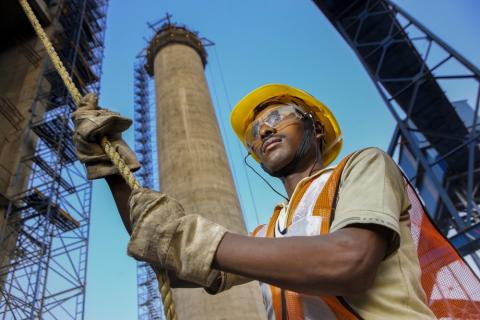Putting people first: The social sustainability facet of the green building industry

The construction industry in India is a behemoth growing at a fast pace. With large and small-scale constructions dotting the cities, it has more than 16% of the Indian population working on construction sites. As per 2011 census, a total of about 482 million labor work force is available in the country. About 94% of the labor is employed in unorganized sectors and the rest are employed in organized sectors in India. The success of a construction project is dependent on timely, economical and systematic construction; to which safety of the structure and the personnel contribute to a large extent, which is dependent on proper coordination between contractors, workforce and client.
The construction workers lead a transient life, moving from site to site. The usual stay at a site is around 3-4 years; which becomes their home during that time. Usually these labor accommodations are makeshift arrangements, with poor sanitation, open defecation, erratic water supply, no access to good lighting or ventilation. Global warming and climate change are bringing forward frequent and severe heat waves which leave the marginalized population such as construction workers vulnerable. The people who construct our glittering cities deserve better and additionally they complete the triangle of sustainability. Being part of the unorganized sector, they have to fight for minimum wages, do not have insurance cover and lack access to medical facilities. Furthermore, the service staff of a building such as cleaners, sweepers, maintenance staff, drivers etc. often do not have access to basic facilities such as dedicated toilets, and restroom for breaks or lunch.
The Directive Principles of the Indian Constitution lay down provisions for the health and strength of the employees, and also mention that just, humane conditions of work, maternity relief must be provided. Although most firms, companies have a safety protocol, guidelines and policy in line with various Acts; however, the safety and sanitation conditions of these people is a concern often overlooked. Since last few years, the focus has shifted to making the construction industry sustainable. Green building design focuses on the climate response design, sustainable materials, energy and water consumption reduction, better occupant comfort and waste management.
GRIHA (Green Rating for Integrated Habitat Assessment), India’s own green building rating system, emphasizes the importance of the labor health, safety and sanitation by enforcing them through a mandatory criterion. Criterion 24 of the GRIHA Version 2015 rating mandates compliance with the NBC 2005 safety norms for providing the necessary safety equipment and measures for construction workers. Task appropriate gear such as Personal Protective Equipment, harness, goggles, hard hats, jackets etc. is mandatory. Additionally, it mandates provision of drinking water, hygienic working and living conditions, and sanitation facilities on site as well as in labor accommodation. All of the mentioned parameters are explained to the project team during the orientation workshop organized upon registering of the project. The contractor, client, and green building consultant are taken through the rating to ensure that the entire team is aware of the requirements. Furthermore, two due diligence site visits during the construction by the GRIHA Council officials ensure that all safety and sanitation requirements are followed on site. A compliance report from the project team is expected to ensure that the concerns raised during the site visit have been addressed on site.
GRIHA encourages provision of creche for the children of construction workers by rewarding it with a point. Safe and clean environment, as well as healthy working conditions, are necessary for achieving social justice and economic growth; and is a fundamental human right which is ensured by the criterion. Other than the aforementioned direct benefits, the criterion inadvertently encourages good practices on site such as the constitution of safety committees on site, regular medical visits, welfare facilities to name a few. The criterion positively influences the provision of segregated facilities for the women workers; thus, encouraging equal opportunities. The most significant change is at the consciousness level of the employers and the awareness level of the employees.
Until we understand that the people constructing our glittering cities spend most of their lives in horrendous, slum like situations and that the most basic human needs are callously infringed; the change cannot happen. GRIHA has been working diligently towards changing the consciousness level of the people involved in construction to create a ripple effect and each version of the rating strives to raise the bar further to manage the social angle of sustainability.